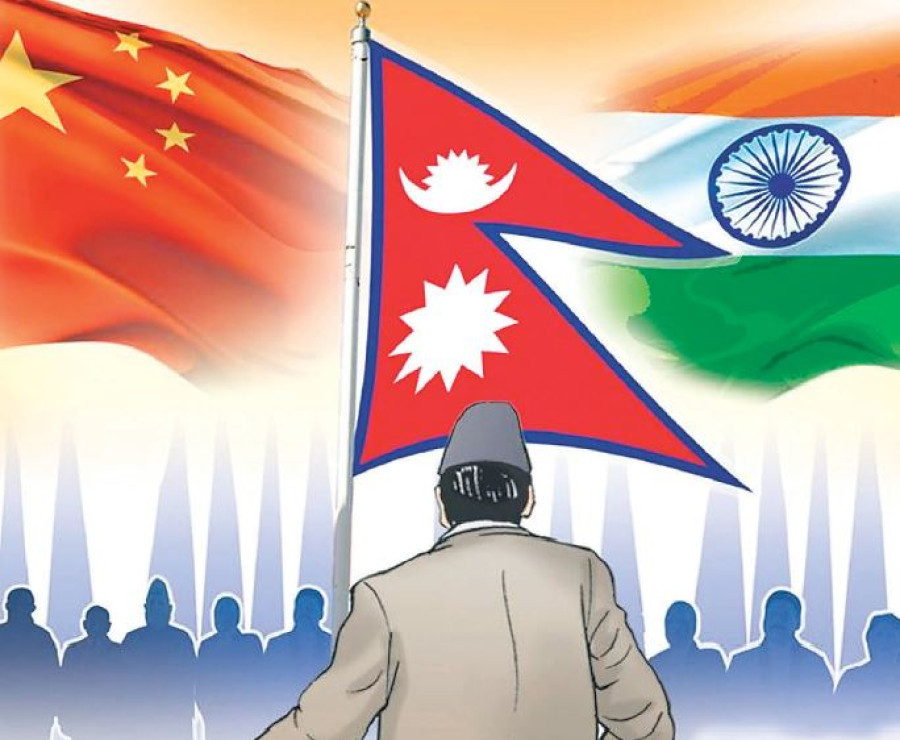Columns
Balancing the dragon and the elephant
Nepal needs support from all donor countries and partners for sustained growth.
Pragya Ghimire
There is a significant difference between what India was 10 years ago and what it is now, as it has taken the front seat in international power politics and achieved many milestones. The country is the fifth-largest economy globally, with more than 7 percent growth rate. With a total asset of $21 trillion, more sovereign investors positively view India for its improved business and political stability, favourable demographics, regulatory initiatives and friendly business environment. Furthermore, the United States counts on India to contain China’s growing power in the Asia-Pacific and other regions. The Group of Seven’s (G7) invitation to India since 2019 demonstrates India’s importance in global power dynamics.
Additionally, India is giving a tough competition to China after the historic Group of 20 (G20) presidency, the success of Chandrayaan-3, and becoming the most populous country. Since 1978, China began to open up and reform its economy, and its GDP growth has averaged over 9 percent a year; in 2023, it is just growing around 5 percent. China’s urban youth unemployment rate has risen to 21 percent as of May 2023, up from 15.4 percent two years ago. Moreover, ongoing real estate market problems are sparking concerns over the stability of China’s financial system, putting the Chinese economy at risk of a deeper downturn. Despite once promoting itself as globalisation’s champion—especially in trade and investment—China’s policies seem inward-looking, given Xi Jinping’s notable absence in major global fora, including the G20 and the United Nations General Assembly.
What’s more, the Belt and Road Initiative (BRI) appears to have lost steam as it has burdened participating countries with debt. Transparency and accountability issues regarding loans, project contracts, environmental and social impact, and the geopolitical implications of China’s influence and strategic leverage are being questioned.
Dahal’s visits to India and China are often seen as a strategic move to maintain balance in foreign relations. Following India’s economic blockade in Nepal in 2015, Nepal expanded its relationship with China with high hopes and expectations. Nepal signed a transport-transit agreement to access seven ports in China; nine BRI projects were selected, and the “Trans-Himalayan Multi-Dimensional Connectivity Network” umbrella concept was presented, enhancing cross-border cooperation. When Chinese President Xi Jinping visited Nepal in 2019, the two countries signed seven bilateral agreements, but most were not implemented.
The Sino-Nepal relationship is neither significantly getting better nor deteriorating. Although Covid-19 was one of the reasons, political hesitancy was the main reason. Such a situation first arose in the latter part of the Oli government when he was trying to improve his relations with India to save his government through so-called “Goyal Sutras”. Deuba’s and Dahal's previous governments didn’t prioritise China relations after the Oli government, fearing a loss of India’s trust and confidence.
As responsible is the changing behaviour of the Chinese side. For many years, China has unwaveringly pursued its friendly policies regardless of the international landscape or the domestic situation in Nepal. However, the country visibly took sides and announced its support for the unification of Nepal’s Communist parties, worsening its relationship with the Nepali Congress and other parties. When the northern border was closed for an extensive period, China only cared about its own interests, disregarding the problems Nepalis were facing. Nevertheless, China widened the trust gap by claiming that the Pokhara International Airport was built under the BRI. It also pressured Nepal to become part of its Global Security Initiative (GSI) and even started openly marketing Xi’s ideology to various Nepali political parties. Chinese Ambassador Chen Song’s recent remark about how India’s policy towards its neighbouring countries, including Nepal, is unfriendly and not beneficial to them stirred controversy.
As Prime Minister Dahal is set to visit China this weekend, to make the visit fruitful, Nepal should focus more on economic and development relations and less on political appeasement. Nepal’s core mantra should focus on expanding its multi-faceted connectivity with India and China. It should be conveyed to China that America’s Millennium Challenge Corporation project was not chosen over China’s BRI and that Nepal is looking for a grant rather than a loan scheme. Nepal is open to any assistance from China that is of long-term significance from the connectivity point of view as long as it will not be a significant threat to Nepal’s debt sustainability.
Nepal should provide the example of its multi-faceted relationship with India to point to China that there is a need to expand the multi-dimensional connectivity network across the Himalayas, including implementing a transport agreement that allows Nepal to use the Chinese border during business with third countries. Nepal should insist on implementing air, rail and sea communication networks across the Himalayas and open all the northern corridors and border crossings to transform from a “land-locked” to a “land-linked” country.
Nepal’s electricity is another potential connectivity area between India and China. India has agreed to import 10,000 megawatts from Nepal in 10 years but has also expressed its reservations to import if Chinese contractors, investors or other external investors are involved in the project. Although the average per unit electricity cost in Nepal, for households and businesses, is below the average cost in China and India, Chinese businesses and companies will also factor in other costs, such as the cost of transmission lines and sub-stations. If the governments of China and Nepal are willing to build the required infrastructure from their resources, there could be a profitable market for importing electricity from Nepal to China.
Nepal seems reluctant to raise the issue of boundaries with its neighbours. During his India visit earlier this year, Prime Minister Dahal refrained from openly raising this issue with Delhi. China has recently published its map, excluding Nepal’s new map, an act that should be questioned through formal talks. This is not to play the China card with India but to remind China that Nepal would like its claim to its own land to be recognised.
Finally, Nepal should communicate that there are no pressures or prejudices towards any of its neighbours. For its development, Nepal will need support and assistance from all donor countries and partners, particularly for expanding its connectivity with India and China. Nepal is not keen on allowing any activities against China, India, the United States or other countries on her soil. At the same time, Nepal will not tolerate any threat or attack on its sovereignty, independence and national integrity from any other country.




 14.12°C Kathmandu
14.12°C Kathmandu















